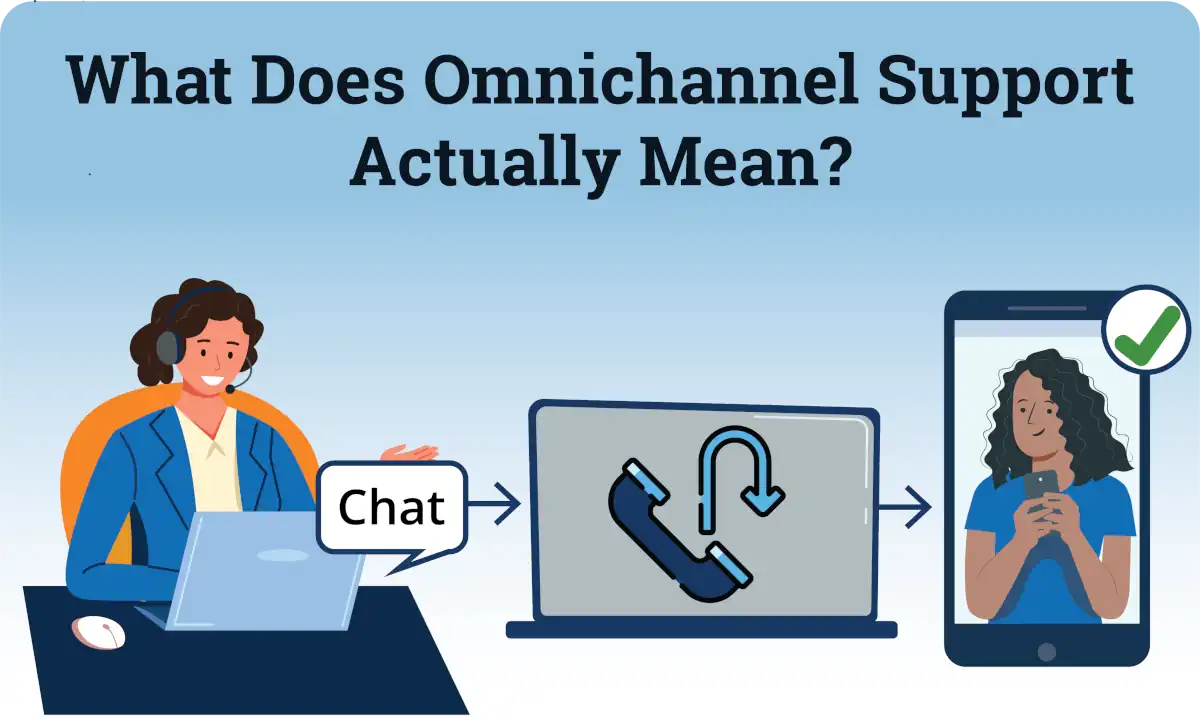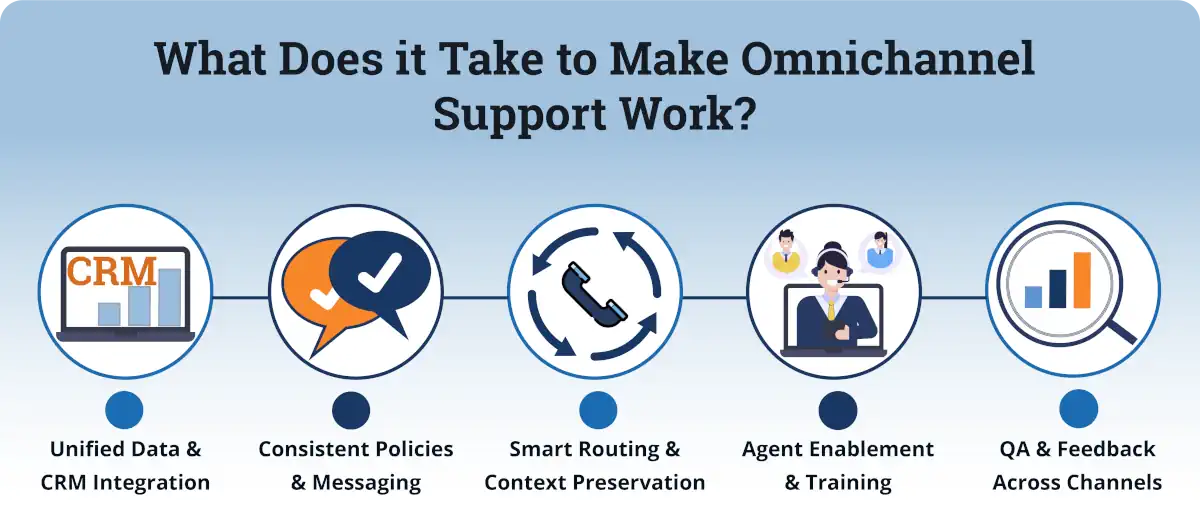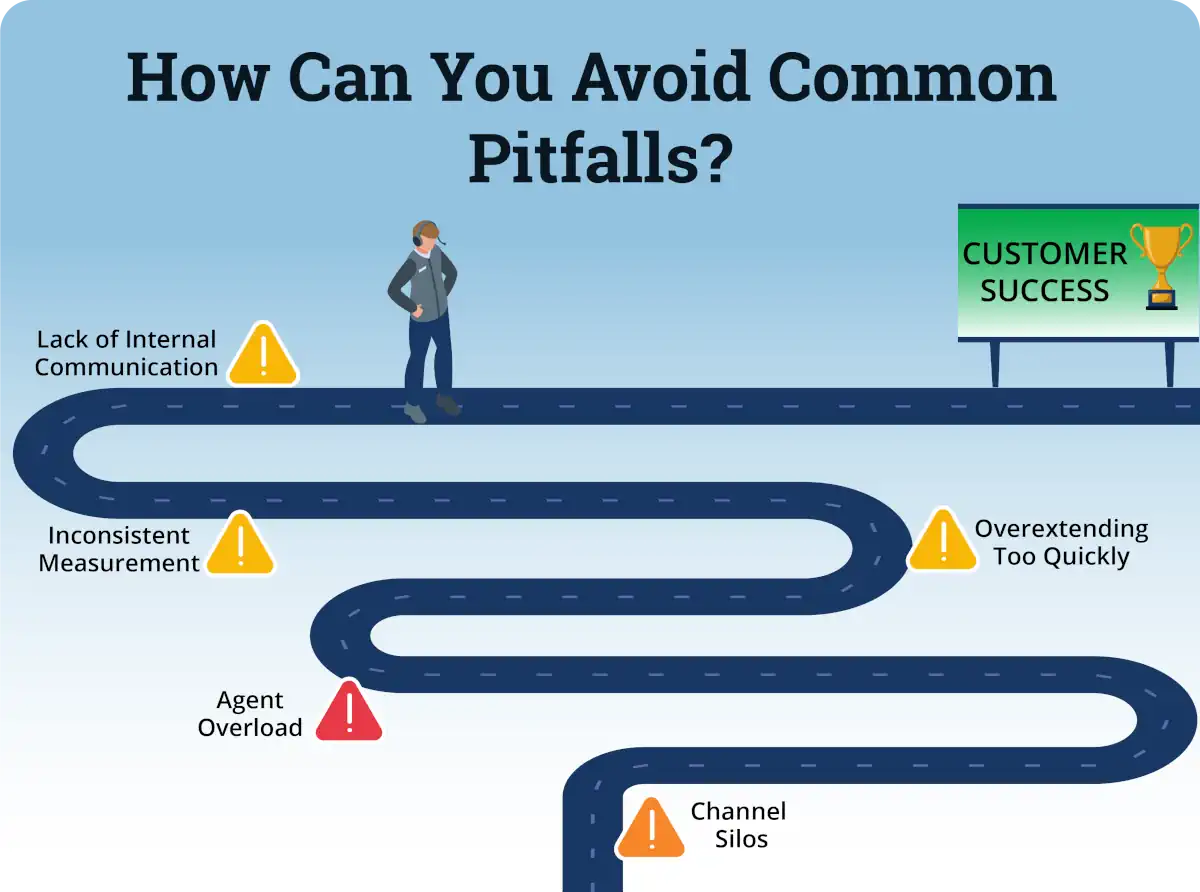You start a live chat about a billing issue, but after waiting for a response, you switch to calling the support line—only to repeat your information all over again. It’s a common frustration that exposes a critical gap in how many organizations manage customer communication.
Omnichannel support isn’t just about offering multiple contact options—it’s about ensuring every interaction feels connected, no matter how customers reach out. True omnichannel support carries the conversation forward, giving agents the context they need to deliver consistent, effortless experiences across channels.
At SQM Group, we understand that seamless experiences don’t happen by accident. They require integrated systems, well-trained agents, and a unified view of customer history. In this blog, we’ll explore what omnichannel support really means, why it matters more than ever, and how organizations can turn disconnected channels into cohesive, customer-first experiences.
What Does Omnichannel Support Actually Mean?
Many organizations think they’re offering omnichannel support simply because they provide multiple contact options—like phone, email, and chat. But true omnichannel support goes beyond channel availability. It’s about creating a continuous, connected experience where customers never have to start over, no matter how they choose to communicate.
In an omnichannel model, every channel shares the same context. If a customer begins on a live chat and later switches to a call, the agent already knows who they are, what issue they’re facing, and what’s been said so far. This reduces frustration, saves time, and builds confidence that the company truly understands their needs.
For agents, omnichannel support also means access to unified tools and data. Instead of jumping between systems or searching for notes, they can view the entire customer journey in one place—making it easier to deliver consistent, personalized service across all touchpoints.

Why Does Omnichannel Support Matter More Than Ever?
Customers today don’t think in “channels”—they just want help, fast and without friction. Whether they message through social media, send an email, or call directly, they expect every interaction to feel like part of the same conversation. When it doesn’t, frustration builds quickly.
Omnichannel support matters because it meets customers where they are while keeping their experience consistent. It eliminates the gaps that happen when systems don’t talk to each other—lost context, repeated questions, or inconsistent answers. For businesses, that means fewer escalations, faster resolutions, and a measurable boost in loyalty.
SQM research shows that customer satisfaction (CSAT) drops with every additional touchpoint a customer uses to resolve an issue. In other words, every time a customer has to switch channels, their experience becomes more difficult. Omnichannel support solves this problem by ensuring continuity—reducing effort, improving First Call Resolution (FCR), and creating smoother, more human interactions.
What Does It Take to Make Omnichannel Support Work?
Building a true omnichannel support system isn’t about adding more channels—it’s about connecting them. Behind every seamless customer experience is a carefully coordinated mix of technology, training, and teamwork that ensures context flows with the conversation.

Below are the essential elements that make omnichannel support successful:
- Unified Data and CRM Integration
Agents can’t deliver connected experiences if the systems they use are disconnected. Integrating data from all communication channels into a single CRM gives agents instant access to a customer’s full interaction history. With this visibility, they can resolve issues faster and personalize their responses instead of starting from scratch each time.
- Consistent Policies and Messaging
A seamless experience depends on consistency. Whether customers contact an agent by phone or chat, they should receive the same answers and tone. Standardized policies and unified messaging prevent mixed signals that can cause frustration or distrust.
- Smart Routing and Context Preservation
When a customer switches from chat to phone or email, their information should move with them. Smart routing tools ensure that handoffs between channels are smooth, preserving the context of previous interactions. This reduces repeat questions and shortens resolution time.
- Agent Enablement and Training
Managing multiple channels takes more than multitasking—it requires strong communication, adaptability, and product knowledge. Agents need the right tools and customer service training to move effortlessly between platforms while keeping the experience personal and efficient.
- Quality Assurance and Feedback Across Channels
To truly measure omnichannel performance, organizations must evaluate both efficiency and empathy across every channel. Incorporating QA reviews, customer surveys, and mySQM™ QA data helps identify gaps and opportunities for continuous improvement.
How Can You Avoid Common Pitfalls?
Even with the best technology and intentions, many organizations struggle to deliver true omnichannel support. The most common challenges don’t come from a lack of tools—but from how those tools, teams, and processes connect.

Below are five common pitfalls that prevent organizations from delivering a smooth omnichannel experience—and what you can do to overcome them. Each one highlights a key opportunity to strengthen your support strategy and move closer to customer success.
1. Channel Silos
It’s easy for each channel—phone, email, chat, or social—to become its own island. When data doesn’t flow between them, customers end up repeating information and agents lose visibility into the full journey. Breaking down these silos through integrated systems and shared dashboards ensures that both customers and agents stay on the same page.
2. Agent Overload
Handling multiple channels at once can lead to burnout and inconsistent service quality. Without proper training and clear guidelines, agents may struggle to prioritize tasks or manage response expectations. Providing focused call center coaching and rotating responsibilities helps balance workloads and maintain service quality.
3. Overextending Too Quickly
Many organizations launch too many channels before perfecting the ones they already have. Adding more touchpoints can spread resources thin and weaken quality. It’s better to start small—optimize two or three key channels—then expand as systems and teams mature.
4. Inconsistent Measurement
Omnichannel success isn’t about volume—it’s about quality and continuity. Measuring only speed or response time overlooks the real goal: making interactions easier and more effective. Tracking customer satisfaction, customer effort, and First Call Resolution (FCR) across all channels paints a more complete picture of performance.
5. Lack of Internal Communication
When departments don’t share information, the customer experience suffers. Collaboration between support, IT, marketing, and operations ensures that everyone understands how each channel contributes to the overall journey. Regular alignment meetings and shared performance goals help maintain consistency and momentum.
Each of these pitfalls represents a common challenge in building a seamless support experience. Overcoming them requires alignment between people, processes, and technology. When teams communicate clearly, measure consistently, and scale strategically, the path to customer success becomes smooth and sustainable.
How Can You Launch Better Omnichannel Support?
Delivering seamless omnichannel support doesn’t have to be overwhelming. The key is to start with a clear plan, focus on the fundamentals, and scale as your team and technology mature.

Building a successful omnichannel strategy isn’t just about launching new channels—it’s about maintaining momentum. Once the foundation is in place, teams should continue refining processes, gathering feedback, and aligning technology to support long-term growth.
Below are five practical steps organizations can take to launch, manage, and continually improve an omnichannel support strategy that delivers seamless customer experiences.

1. Start Small and Build Gradually
You don’t need every channel active on day one. Begin with the most used touchpoints—typically phone, chat, or email—and make sure they’re connected and consistent before expanding further.

2. Map the Customer Journey
Understand where and why customers switch channels. Tracking their path helps you identify weak handoffs, gaps in communication, and moments that cause frustration. Use this insight to prioritize improvements.

3. Train and Empower Agents
Omnichannel success depends on agents who can confidently move between channels while maintaining quality. Offer call center training focused on multitasking, workflow easier, not more complicated.

4. Use Data to Drive Continuous Improvement
Regularly review customer feedback, survey data, and QA results from mySQM™ QA to spot trends and challenges. Use this information to guide coaching, enhance routing, and fine-tune the customer’s journey.

5. Align Technology and Teams
Technology only works when teams are aligned. Ensure IT, operations, and customer service work together to implement changes, track results, and maintain consistent performance.
Delivering Seamless Support Across Every Channel
Omnichannel support isn’t about being everywhere—it’s about being connected everywhere. True customer experience success comes when every channel, agent, and process work together to deliver consistency, empathy, and ease. When customers can move between touchpoints without friction, they feel understood—not just served.
At SQM Group, we’ve seen how aligning data, technology, and coaching turns everyday interactions into seamless experiences. By empowering agents and uniting systems under one customer-focused strategy, organizations can create effortless support that builds trust, satisfaction, and loyalty at every turn.
